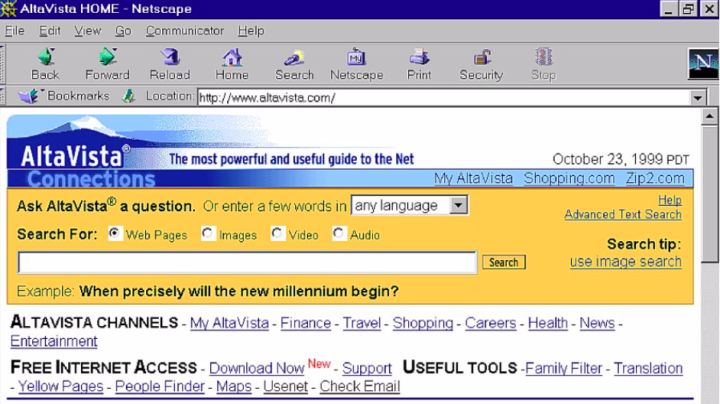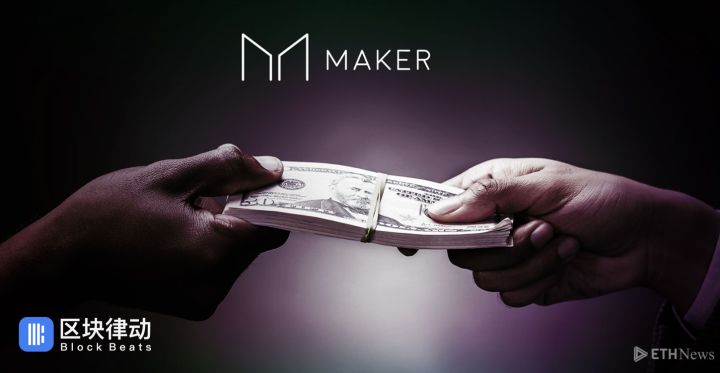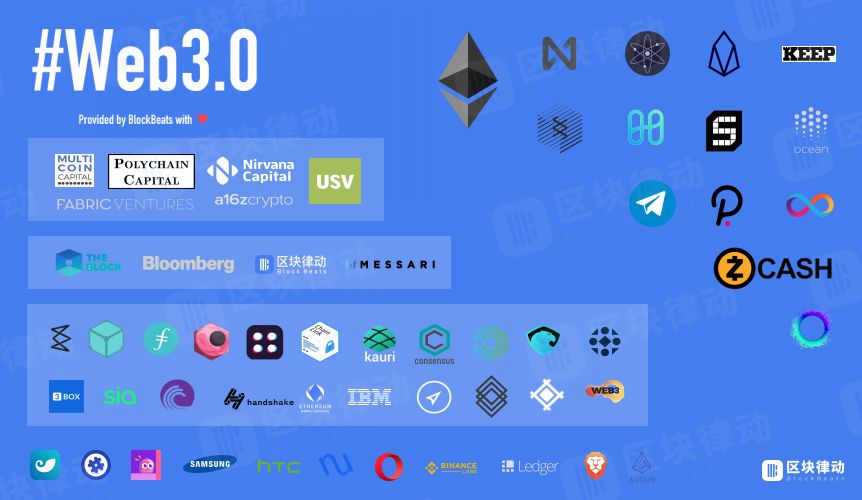What is Web 3.0?
When you watch "Chang'an Twelve Hours" at home, a cloud mining machine next door to Lao Wang's home is constantly transmitting the next set of video files for you; you paid 15 yuan to the video site to watch the show. Member fee, Pharaoh’s mining machine earned 2 cents a day by relying on documents for nearby people.
You are an ordinary Internet user and the two dogs are Web 3.0 participants.
In the near future, you may have heard a lot of content related to Web 3.0. Are you thinking like a member of the BlockBeats team: What is the relationship between Web 3.0 and blockchain?
Traditionally, Web 3.0 is a new phase of Internet development. It's based on the current Internet (or you can call him Web 2.0), and the changes brought about by Web 3.0 bring the Internet to a whole new level of development. Computer scientists and Internet experts believe that these changes will make the Internet smarter and our lives will become easier.
- Blockchain Weekly | A week of financing 13 over 80 million US dollars, the public chain is favored by VC
- "New and old" exchanges compete on the same stage, how can you play in the future? | Interview with SheKnows
- Popular Science | Looking at the footprints of Ethereum from previous upgrades
Practitioners in the digital cryptocurrency industry have given Web 3.0 higher expectations, and they are now looking forward to breaking the monopoly of traditional Internet giants and creating a new world of freedom. The Web 3 Summit (Web 3 Summit), which opened on August 19 in Berlin, will also fully discuss the topic of Web 3. Perhaps we can learn more about Web 3 at this event.
Therefore, in order to better understand the changes in these paradigm shifts, let us first look at the development stage of the Internet.
Web 1.0 -> Web 2.0 -> Web 3.0: Constant Evolution

The trend we are about to witness is that the Internet will evolve with the needs and use of users and ultimately be attributed to users.
Web 1.0 – Website feed information to users

According to the contents of the BlockGeek website, as early as the Internet became popular in the 1990s, user interaction with the web was at a very early stage, where users could only passively browse text, images, and simple video content. What the website offers, What the user is looking at. There is almost no interaction at all.
For the post-90s and 00s, there was an Internet (early) version before social media and video streaming! In the mid-to-late 1990s, before the development of Google and Baidu, the Internet was dominated by AltaVista and Netscape. At the time, the Internet existed only to promote their physical companies. These sites are "read-only", meaning you can only search and read information.
(# Block Rhythm Blockbeats Note: AltaVista, one of the world's best-known search engine companies, was founded in 1995. It was acquired by Yahoo in 2003 and Yahoo! announced the closure of the search engine AltaVista service in 2013. Netscape, Netscape Communications, was once A computer service company in the United States is known for its Netbella Navigator, the same name web browser. In November 1998, Netscape was acquired by AOL.
The e-commerce website of that era is actually the same as the promotional manual issued by the supermarket now, just to show you the content, you can not place orders on the website.
This is Web 1.0, Slow Web 1.0, and fully controlled Web 1.0.
Web 2.0 – the Internet begins to interact with people

The next generation of the Internet is called the "Web 2.0" or "read and write" network. Now, users are more than just simple visitors, they can also create their own content and upload it to the site. For example, in the famous video blogger "Office Ono", it took her only two years to change from an obscure video author to a video with a monthly income of tens of millions.
Probably since 2003, O'Reilly Media's vice president, Dale Dougherty, first proposed the term "Web 2.0," followed by a wave of "Web 2.0" that swept the world. In just a decade, "Web 2.0" completely redefines marketing and business operations.
Influential net red only needs to send a video to make a restaurant full of long queues, or you can use a sentence to make a shop online bad reviews. The influence of Internet people on the Internet is increasing day by day. The era when websites have given users information has passed.
The main goal of Web 2.0 is to make the Internet more democratic and as accessible as possible to users.
Web 3.0 – more humane internet
In the eyes of traditional Internet people, Web3 may be like this.
Every time you buy something on Jingdong, the website's algorithm will recommend it by looking at other products purchased by users who have purchased a product like you or based on your previous browsing history and purchase history. What happened during this process? The site is learning your potential preferences from other users and then recommending what you might like. In essence, the website itself is learning and becoming more intelligent.
They believe that "Web 1.0 is primarily driven by content generated by companies or organizations to attract their customers. Web 2.0 enables the Internet to evolve by uploading and sharing their content on the site. Web 3.0 through online applications and websites Receive information on the Internet and provide users with new information or data."
For example, what is the difference between Semantic Network , "I love Bitcoin" and "I <3 Bitcoin"? The syntax between the two sentences is different, but the semantics are the same. In our case, semantically processing the meaning or emotion conveyed by the data makes both sentences express the same emotion. Semantic Web and artificial intelligence are the two cornerstones of Web 3.0. With semantic metadata, Web 3.0 will enhance the connection between data. As a result, the user experience will evolve to another level of connectivity that can take advantage of all available information.
Another example is artificial intelligence , which will filter through the website and provide the best data to the user as much as possible. In the current Web 2.0, we have begun to adopt user opinions to help us understand the quality of specific products or assets. A website like Rotten Tomatoes, where users can vote for a movie. Movies with higher scores are generally considered to be "good movies." Such a list can help us get "good data" without having to get "bad data."
Like advanced 3D images, imagine that in online games like Second Life or World of Warcraft, users are more interested in their online characters than they are in real self. The level of interest. Philip Rosedale, the founder of the game Second Life, believes that virtual identity will be as popular as email addresses and mobile phones. This view seems a bit far-fetched, but don't forget that in 1997, only a few people had their own email address in 1997. And there will be more and more people with 3D status in the future.
Finally, the Internet will be everywhere. We have already got this feature in Web 2.0. For social media sites like Instagram, users can take images on the camera and upload and distribute them online to become their intellectual property. As a result, images become ubiquitous and ubiquitous. The development of mobile devices and Internet access will enable Web 3.0 to be experienced anytime, anywhere. The Internet will no longer exist on the desktop like Web 1.0, and it will no longer exist on smartphones like Web 2.0. It will be ubiquitous. Web 3.0 can also be called a ubiquitous network because most of the things around you are connected online, the Internet of Things.
* Part of this article was translated from BlockGeek.
Real Web 3.0 – the Internet controlled by people
From the above description, Web 3.0 is a more suitable Internet for human use, and its service to human beings is more excellent and natural. But what does this mean? This means that users need to provide their information in large quantities to artificial intelligence and service providers in large quantities, let them train AI models to provide better recommendations and semantic associations, and the ubiquitous Web 3.0 experience will also lead to Internet users. The disappearance of privacy, the business knows who you are, knows what you like to eat, and you know very little about the business.
Privacy, data, rights, review, identity… This is the topic of blockchain Web 3.0.
In the digital cryptocurrency industry at the forefront of Internet technology, insiders have a very different view of Web 3.0. They believe that the Internet has long been riddled with holes. The four attributes mentioned above are only the stages that the Internet development will inevitably experience, but not enough to constitute Web 3.0.

Several features of true Web 3.0
If the office's advertising share is 100%, rather than the platform is 30% or 40%, then she will get more income. But in the current Internet phase, this goal is almost impossible to achieve, because the traditional Internet is centralized and monopolized by the Internet giant, operators need to pay for various costs.
Web 3.0 requires a new paradigm to disrupt the monopoly of today's Internet giants and protect the interests of every Internet user. Thanks to the decentralized storage of blockchain technology, the inability to tamper with, and the encryption of information, combined with the recent research summary of BlockBeats, Web 3.0 can be roughly labeled with 4 tags:
1. Unified identity authentication system
2. Data confirmation and authorization
3. Privacy protection and anti-censorship
4, decentralized operation
In view of the many problems that have arisen on the Internet, such as the need to repeatedly register accounts, the abuse of user privacy data by service providers, the profitability of network companies using user data, and the inability of network services to continue, they can use the four labels mentioned above, either individually or in combination. , become the solution for Web 3.0. The corresponding properties, block rhythm BlockBeats will be explained and discussed in detail in the following articles.

The block rhythm BlockBeats will also give readers a optimistic view of Web 3.0 and not optimistic about Web 3.0, giving readers a comprehensive understanding of Web 3.0.
Web 3.0 will bring a transparent, trusted Internet economy model
Because users have been using Internet content for free for decades, everyone is not disgusted with the method of using personal data through the User Agreement and the Privacy Agreement to the website or service provider. It is even a matter of course. . However, we have neglected that the money earned by the company using the user's data will not be returned to the user, and the user will not be entitled to the profit remaining after the income covers the operating cost. Many people think this is a matter of course, but it is not fair.
Whether it's Web 1.0 or Web 2.0, the centralization of operational services always brings transparency and trust to a greater or lesser extent. This problem can be solved by the application of block equity technology for data rights pass-through, data validation and authorization. The data generated by the user in the world of Web 3 is owned by the user, and the user has no right to use it without being authorized by the user. At the same time, the revenue generated by the use of data, users may also get a share of the pass-through economy of the digital encryption currency industry.
The emergence of the universal economy and digital assets has also given users the opportunity to participate in the operation of Web 3.0 development companies. They can participate in voting and participate in dividends to achieve a positive interaction between developers and users. The user is both a user and a maintainer. For example, the Brave browser recommended by block block BeatBeats, when the user accesses the Internet in the browser, the browser will recommend the advertisement to the reader, and at the same time, return some income to the reader. It consumes both user data and revenue for users. There will be more such products in the future, allowing users to participate in the company's operations. According to Fred Wilson, AVC Capital Partners, this behavior can be understood as Open Data, an important part of Web 3.0 development.

The Lao Wang mentioned at the beginning of the article, because he participated in the mining of a project, his mining machine was used as a CDN node of the video website, to deliver video files to nearby video users, and to calculate the traffic according to the uploaded traffic. The amount of work, and then from Youku or iQiyi or Tencent video. Pharaoh is a very standard participant in Web 3.0. He can enjoy the convenience of the Internet and make money for his contribution.
Web 3.0 will give users peace of mind
In the traditional Internet field, users have very low control over their own data.
For example, the article you posted on the blog may have been deleted because of a "stop service announcement" on the Sina blog. Even if you buy the copyrighted music on Netease Cloud Music, it will be deleted from the App due to the expiration of Netease Cloud's copyright, and you will never hear it. Your beloved game may also be "disconnected from the server" because the developer can't make money, so it takes you a few months to get the equipment out.

In the traditional Internet world, this has happened and more will happen. In the Web 3.0 era, this problem will be solved through decentralization.
The blockchains of the world's computers, such as Ethereum 2.0 and Dfinity, will provide developers with basic computing services. They do not need to rent servers. Users' data can also pass IPFS, Sia, OrbitDB (using IPFS decentralized databases). ) Technology and other decentralized storage, no one can control your data. As long as you are willing to pay for the blockchain smart contract that the game runs, even if you only have one person left in the game, you can still play.
Changes to products and games must also be approved by the community, and developers no longer have the power of dictatorship. Ethereum founder Vitalik Buterin is mad at the random modification of character skills in the online game World of Warcraft. The emergence of Web 3.0 will limit this.
Web 3.0 is ruthless but can be unusually fair
Web 3.0 is actually cold, it doesn't bring emotions, only then can it be loyal to everyone.
The application of Web 3 in the financial sector will also surpass our imagination of the current financial industry, and has already landed. Take MakerDAO's decentralized lending platform as an example. On this platform, users can obtain the stable dollar DAI anchored by the dollar through over-collateralized digital assets.
Blockchains and smart contracts have no feelings. They treat everyone equally. They only recognize the unchangeable records recorded on the chain and the real digital assets.

When you walk into the bank, the bank checks your qualifications, checks your source of funds, and then, after a lengthy review, your mortgage gives you a loan; in Defi (Decentralized Finance) in Web 3.0 There is no such a centralized organization to compare and review. Whether you are a tramp who is driven out of the house or a Wall Street tycoon wearing a suit, the MakerDAO smart contract deployed on the Ethereum blockchain will be unconditionally Receive your digital assets and lend you a stable currency.
In the real world, you may be able to gain the trust of others through rhetoric, and Web 3.0 does not listen to this. It is a machine without feelings. It does not deceive people, nor can it be deceived. It also can be almost "trusted" to do business on the blockchain. This behavior is called Fred Finance by Fred Wilson.
Web 3.0 is inefficient and difficult to popularize
But there is no denying that the new Web 3.0 world has a very big problem: inefficiency. This is directly related to the decentralized operation of Web 3.0 recognized by blockchain practitioners. The efficiency of decentralization is much lower than that of centralized Web 2.0 and traditional Web 3.0.
The first is that decentralized networks are slow to handle tasks. BlockBeats believes that any blockchain industry practitioners will recognize that even those blockchain projects known as Web-level can't hide inefficiencies. The fact; then the hidden costs that need to be paid for using the decentralized network, users who enter Web 3.0 will be confused by the concept of "fee", and the original Internet does not have a fee.
Web 3.0 requires far more knowledge of user science than blockchain, bitcoin, and cryptocurrency. Of course, developers can design applications that are no different from traditional apps through a variety of designs, so that users do not feel the existence of these complex operating mechanisms. But such development tools are just getting started.
The popularity of Web 3.0 may be very difficult, whether it is the popularity of developers, the popularity of users, or the popularity of enterprises, it will be unusual. Especially in the era when countries and regions around the world are trying to strengthen Internet governance, Web 3.0 is confronting politicians.
Coupled with the general economy and human selfishness, speculation is far more profitable than doing projects. In order to gain public trust, the development team even needs to show up regularly to prove that they are still working. How to operate the blockchain like the traditional Internet, while maintaining the characteristics of the blockchain, is still a headache for the blockchain developers.

Is Web 3.0 worthy of existence?
This is the vast majority of voices against the concept of Web 3.0. They believe that today's Internet has developed to an almost perfect stage, users have become accustomed to selling data, accustomed to the subscription system, and accustomed to this after they are reluctant to enter the Web 3.0 world.
In this regard, they believe that the concept of Web 3.0 does not exist, because it has now entered the Web 3.0 phase. From a user-accepted perspective, Web 3.0 seems to be no need to exist, because today's Internet is enough to meet everyone's needs.
But from the perspective of decentralization and personal protection, Web 3.0 has its value. But how valuable it can be, waiting for the market to test. This can take a long time. Web 3.0, which is considered from the perspective of digital cryptocurrency market, has its existence, but whether its existence is worth our time to wait is another matter.
To be sure, whether it's a developer, a blockchain operator or a user, Web 3.0 is no longer just like Web 2.0, just waiting to be enjoyed. Only active participation can create such a real enjoyment and travel obligation. New internet world.
Author: 0x2
Source: block rhythm
We will continue to update Blocking; if you have any questions or suggestions, please contact us!
Was this article helpful?
93 out of 132 found this helpful
Related articles
- The State Council supports Shenzhen to launch digital currency innovation applications; Bakkt officially launched Bitcoin futures in September
- The pledge mining ecology has gradually prospered, but still faces many challenges. Can you still feel comfortable with Staking?
- My coins have been stolen, how are they washed white?
- Bitcoin challenges $11,000, and mainstream currencies rebound strongly. Where is the market going?
- Research on the Correlation between Bitcoin and Gold
- Bakkt's crypto asset market expansion is a positive trend
- The blockchain is “useless”, why are we still gambling on the future and not willing to leave? | 2019 than the original chain global developer conference






